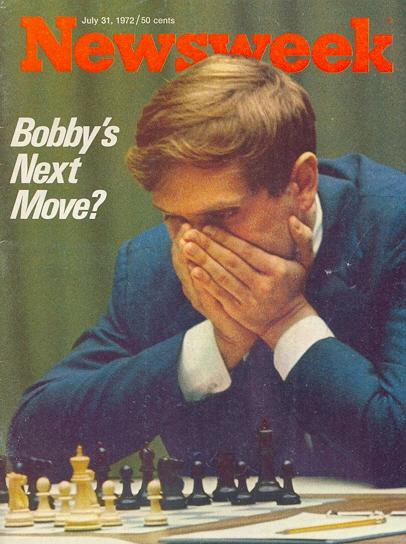
When contacting us by e-mail, correspondents are asked to include their name and full postal address and, when providing information, to quote exact book and magazine sources. The word ‘chess’ needs to appear in the subject-line or in the message itself.
| First column | << previous | Archives [21] | next >> | Current column |

Pages 4-7 of the January 1973 Chess Life & Review transcribed interviews (originally published in the Icelandic magazine Skák) by Gligorić with Fischer, Spassky and Thorarinsson for a radio audience. A compilation of some remarks by Fischer is given below:
C.N. 3972 presented a photograph of Stephen Fry playing chess and now we quote, with his kind permission, extracts from two chess articles by him. The first, ‘Chess Piece’, was published on page 23 of The Listener, 24 November 1988:
‘The sight of a pasty-faced creature in bottle-end spectacles pushing little wooden men around a board hardly qualifies as throbbing pageant. Knowing the rules isn’t enough either. You can sit in a hall and try to follow a game of grandmaster chess and be certain that the only people in the world who have the faintest grasp of the position on the board are the two players playing. Ex-world champions and mighty pundits have all been known to watch a difficult game and announce, say, that Scratchkov is looking good and winning comfortably, only to be startled and humiliated by Scratchkov’s sudden resignation. There’s nothing hidden, the pieces are on view for all to see, but the intellectual complexity and the depth of analysis demand such concentration that a game can only really be understood even by the worthiest masters when it is published with annotations months after it has been played.’
‘The fact is that chess is completely pointless. As Raymond Chandler so rightly said, it is the greatest waste of human intelligence outside an advertising agency. So I would urge you all to make a daily check on the English position in this current Olympiad and celebrate with me the fact that as a nation we have found true world class in an activity that is joyously, arrogantly, unrepentantly useless, unproductive, unhealthy and wonderful. Only when we can take pleasure in things done entirely for their own sake will we discover how to succeed in more useful activities. That is what play is all about.’
The second article by Stephen Fry was entitled ‘Giving the Smyslov Screw a theatrical twist’ and appeared in the Daily Telegraph, 26 October 1990, page 21:
‘My own theory, and I cannot emphasize its worthlessness enough, is that chess is fundamentally a theatrical affair. I first became really interested in the game when I heard about the Smyslov Screw. There was a great Russian world champion, who recently enjoyed something of an Indian summer, called Vassily Smyslov, particularly noted as a master of the endgame. Whenever he moved a piece from one square on to another he had a habit of twisting it, as if screwing it into the surface of the board.
Others might drop their man lightly or bang it aggressively, Smyslov gently screwed it in. The psychological effect of such a move can be devastating. It looks so permanent, so deliberate, so absolutely assured. Kasparov hunches himself over the game, in a brooding, minatory and virile manner that is worth at least three extra pawns.’
After a discussion of historic parallels between the schools of drama and of chess (Classical-Romantic, Modern, Hypermodern, and post-Modern/post-Hypermodern) the article concluded:
‘If we wish to achieve real supremacy in chess we must stress those qualities that have given our drama its greatest strength: the eccentric, the bizarre, the comic, the mannered and the elegant; the same qualities we associate with, say, Stoppard or Olivier. We must at all times refrain from the conventional, the orthodox, the pedestrian and the timid. We need chess equivalents of Alastair Sim, Ralph Richardson, Maggie Smith, Noël Coward, Arthur Lowe and Alan Bennett: absolute mastery, benevolently disguised.Chess is indeed like life, for we need people of precisely those qualities in all aspects of our national existence. If we have a contribution to make to the world that might stave off grey-suited stalemate it is to offer a bouncy, charming, unorthodox and theatrical flair.’
Staunton was well known for making ‘rude’ replies to correspondents in his Illustrated London News column, but some other editors of the time wrote similarly. Here is C.H. Stanley answering ‘Draw Game’ of Philadelphia in Harper’s Weekly, 30 October 1858:
‘You must really obtain some elementary work, and exhibit it in small doses, or ask some old lady in your neighborhood. Anyone, we should think, could answer your queries who had ever attempted to play a single game.’

In C.N. 3770 Calle Erlandsson (Lund, Sweden) presented a painting by the Finnish artist Antti Favén (1882-1948), but little progress has yet been made in identifying the players. Tarrasch is clearly in the top left-hand corner, and the figure in the centre background, with a cigar, is Marshall. Is Alekhine lighting a cigarette in the centre foreground? Moreover, Gerhard Josten (Cologne, Germany) suggests that the man seventh from the right is Emanuel Lasker.
Two chess poems by Tartakower in German were published on page 74 of Kagans [or sometimes, as here, Kagan’s] Neueste Schachnachrichten, January 1922 and on page 170 of the April 1922 issue:
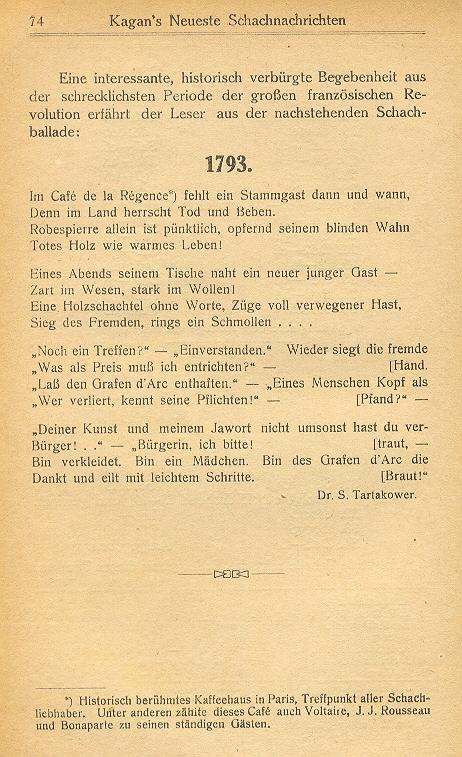
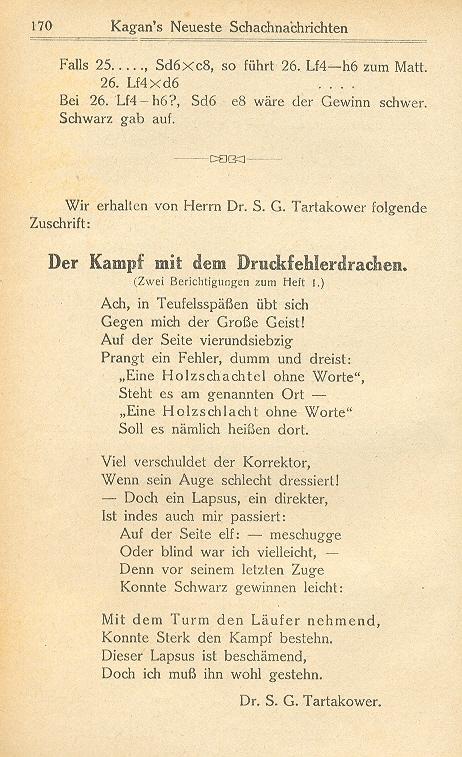
Tartakower’s oft-quoted commentary on Lasker, Capablanca and Alekhine (see, for instance, pages 3, 18 and 29 of the Baden-Baden, 1925 tournament book published by Caissa Editions in 1991) was presented as follows by Koltanowski on page 52 of the Chess Digest Magazine, March 1972:
‘Tartakower, when Alekhine was stunning the chess world in 1930-33, made this witty remark: “Lasker was world champion, Capablanca is world champion, and Alekhine plays like a world champion.’
Since Alekhine became world champion in 1927, this is just another example of Koltanowski’s difficulty with elementary facts.
Regarding the game Bondarevsky v Ufimtsev, Leningrad, 1936, Dan Scoones (Victoria, BC, Canada) provides a link to the crosstable of the event, which was won by Bondarevsky. Our correspondent comments:
‘Unfortunately, Bondarevsky v Ufimtsev is not included in the small selection of games. The RusBase project represents a transfer of material from Soviet magazines and year-books, so it seems unlikely that it was ever published.’

This is Martín (de) Ortueta, whose spectacular loss to Sanz has been widely published and discussed. The photograph appeared opposite page 48 of El Ajedrez Español, October 1934.
Not every reader may succeed in identifying the player purportedly depicted in this painting:

As is well known, Peter Mark Roget, the creator of Roget’s Thesaurus, also came up with ‘The Economic Chess Board’. (See, for example, the ‘pocket set’ entry in the various editions of The Oxford Companion to Chess.) Now, though, Alan McGowan (Waterloo, Canada) points out that Roget was mentioned in The Chess Congress of 1862 by J. Löwenthal (London, 1864) in another connection. The book contains a selection of problems entered for a competition, and a list of ‘Ordinary Problems’ appears from page lxxviii to page lxxx. Number 14, on page lxxviii, is ‘Davus sum – Non Oedipus’, P.M. Roget, M.D. London.
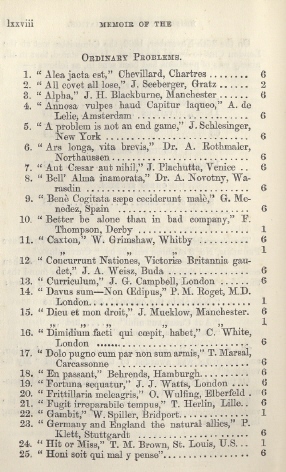
Mr McGowan comments:
‘The book shows that he submitted one problem. Most competitors sent in a set of six, although others submitted sets of three or, like Roget, just one problem. His composition did not win a prize. Between pages 383 and 425 a selection of “Ordinary Problems” by unsuccessful competitors is presented, but Roget’s is not there.’
What is known about Roget’s interest in chess problems or in chess in general?
Below is a reference to Alekhine from page 184 of Grandmasters of Chess by Harold C. Schonberg (Philadelphia and New York, 1973):
‘It infuriated him when his name was pronounced Al-OKCH-in. That was a Jewish pronunciation; the correct pronunciation was Al-YEKCH-in.’
What evidence exists that any particular pronunciation of his name infuriated Alekhine? An ipse dixit by Schonberg hardly suffices.
Michael Clapham (Ipswich, England) quotes the following by D.J. Morgan on page 111 of the March 1974 BCM:
‘3 (to 5) July 1908. First game by wireless telegraphy in mid-ocean, between groups of players on the Cunard liners Campania and Oceania [sic] (Game in BCM, August 1908).’
A report and the game-score appeared on pages 349-350 of the August 1908 BCM, courtesy of ‘Mr Beynon of the Cunard Company’. The Oceanic team played Black:
E.A. Letcher, V.P. Letcher and J. Galindez – F. Altschul, W.E. Farr and Dr Raymond1 e4 e5 2 Nf3 Nc6 3 Bc4 Bc5 4 b4 Bb6 5 c3 Nf6 6 d3 d6 7 Qb3 O-O 8 Bg5 a5 9 b5 a4 10 Qc2 Ne7 11 Bxf6 gxf6 12 h4 Be6 13 Nbd2 d5 14 exd5 Bxd5 15 Bxd5 Nxd5 16 g3 Qd7 17 Ne4 f5 18 Neg5 f6 19 Nh3 Nxc3 20 O-O Nxb5 21 Kh2 Bd4 22 Rac1 c6 23 Ne1 Nc3 24 Qd2 Nd5 25 Nc2 Bb2 26 Rb1 Ba3 (Since this leaves the bishop en prise it may be wondered whether the BCM score was correct.) 27 f4 b5 28 h5 Bd6 29 fxe5 Bxe5 30 d4 Ne7 31 Qe3 Bd6 32 Nf4 Bxf4 33 gxf4 Qd6 34 Rbe1 Rf7 35 Rf2 b4 36 Qf3 Nd5 37 Ne3 Nxe3 38 Qxe3 Raa7 39 Rg2+ Kh8 40 Reg1 Qf8 41 Qe6 Rg7 42 Qxc6 a3 43 Rg3 Rxg3 44 Rxg3 Rg7 45 Qc1 Rxg3 46 Kxg3 Qg8+ 47 Kf2 b3 48 axb3 Qxb3 49 Qe1 a2 50 Qe8+ Kg7 51 Qe7+ Qf7 52 Qa3 Qe6 Drawn.
From pages 222-223 of Patches of Sunlight by Lord Dunsany (London, 1938). The author describes sailing in the Red Sea in 1913:
‘I played chess with the captain, as I nearly always do in ships, for I have hardly ever met a captain of a ship who did not play chess well, those 64 squares perhaps providing the readiest land for a holiday, where his thoughts can go ashore for a while when his body is out in an ocean.’
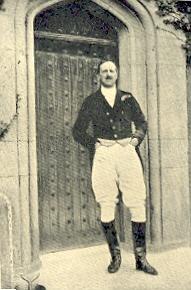
Lord Dunsany
Chess with the Captain was, moreover, the title of a short book of memoirs by H.A. Samson (published in 1992):


The painting, by John McGrew, was intended to depict Garry Kasparov. No reader sent in the right answer, and ‘Spassky’ was the first suggestion received. However, from Mr McGrew’s brush this is Spassky:

Michael McDowell (Westcliff-on-sea, England) remarks that J. Kling’s The Chess Euclid (London, 1849) included among the list of subscribers ‘Roget, Dr, 18 Upper Bedford Place’.
Our correspondent also forwards this problem by Roget, from page 617 of the Illustrated London News, 29 June 1861:
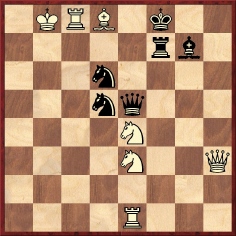
Mate in four.
From Avital Pilpel (Haifa, Israel):
‘Some evidence of Alekhine being annoyed at the pronunciation “Al-OKCH-in” – though without any reference to this being the “Jewish” pronunciation – is a paragraph on page 17 of the January 1972 issue of the Israeli magazine Shachmat, in a report on the Alekhine Memorial Tournament (my translation from the Hebrew):
“Al-YEKCH-in and not Al-OKCH-in [The spelling of the two pronunciations differs in Hebrew. A.P.]. In Hebrew (and other languages) the wrong pronunciation (and spelling) of the ex-world champion’s name took root for some reason. Alekhine’s own insistence on the right pronunciation can be demonstrated by the fact that, if someone asked on the telephone, “Can I speak with A.A. Al-OKCH-in?”, Alekhine would reply, “there is no such person, there’s Al-YEKCH-in”. (This is what Lev Lubimov writes in his book In Exile. During his years as an émigré from Russia the writer would often meet with Alekhine.) It is corroborated too by chess players who knew Alekhine, and if anybody needs more proof, in English the name is written ‘Alekhine’. It seems to us that the evidence is conclusive on this question.”
Can anyone give chapter and verse from the Lubimov book?’
Hassan Roger Sadeghi (Lausanne, Switzerland) asks for more information about a statement by Christiaan M. Bijl on the first page of his Foreword to The Monte Carlo Tournament of 1903 (Zurich, 1983):
‘World champion Lasker did not take part; he had just taken up residence in St Louis, USA, as assistant professor of mathematics.’
Perhaps a reader can provide details of Lasker’s various academic postings. As regards St Louis, we note the following on page 133 of Checkmate, March 1903:
‘Dr Lasker has accepted a mathematical tutorship at the St Louis (MO) University, it is reported.’
Below is Christiaan M. Bijl’s bookplate, reproduced from one of our copies of Izbrannyye partii by V. Smyslov (Moscow, 1952):
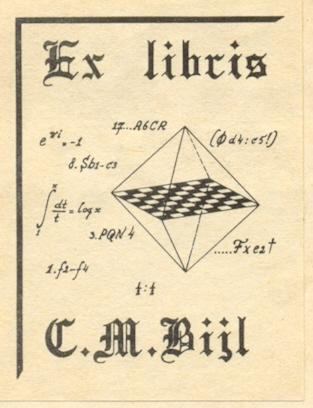
What more is known about the ‘Smyslov Screw’ referred to by Stephen Fry (C.N. 4275)? Given that we recalled a 1970s Master Game television programme (BBC) in which the commentator, Leonard Barden, referred to Smyslov’s way of handling pieces (albeit deft captures in a single sweep, we thought, rather than screwing pieces into the board), we raised the matter with Mr Barden. He has replied as follows:
‘I’m sure I said it or wrote it in more than one place, and I was referring to the placing of Smyslov’s own piece as well as a capture of his opponent’s. I think many grandmasters have acquired the technique of a brusque swooping action when capturing. But my memory is that the original observation was made by Hugh Alexander, probably after his defeat by Smyslov in the Britain v Soviet Union match of summer 1954. Alexander also remarked on Botvinnik’s habit of writing his move down with careful precision, so that the opponent felt like resigning at move one. In 1960 I had the privilege of 14 blitz games with Robert Fischer when he visited my house. I lost 1½-12½, which I thought a good result for me, and was physically overawed, as were others, by Fischer’s large hands and talon-like capturing mannerism. So on more than one occasion, which doubtless included The Master Game, I brought these three cases together, with others, as examples of how lesser lights were subliminally intimidated by the greatest masters. I could well have said something like this, too, in the BBC Network Three radio chess programmes which antedated The Master Game by a decade. Later, of course, the technique moved to a more sophisticated level with Kasparov’s bombardment by thought waves ...’
As regards Botvinnik, the following passage from page 16 of C.H.O’D. Alexander’s A Book of Chess (London, 1973) is worth noting:
‘If you play Botvinnik, it is even alarming to see him write his move down. Slightly shortsighted, he stoops over his score sheet and devotes his entire attention to recording the move in the most beautifully clear script; one feels that an explosion would not distract him and that examined through a microscope not an irregularity would appear. When he wrote down 1...c2-c4 [sic] against me, I felt like resigning.’
We take the game in question to be Alexander v Botvinnik in the Amsterdam Olympiad of 1954, a Sicilian Defence.
In a letter to us dated 11 February 1972 C.H.O’D. Alexander wrote:
‘Capa was undoubtedly one of the two or three most gifted players who ever lived – but lazy (that’s why Alekhine beat him). Nowadays he would have to work much harder – especially at the openings – than he did. I think Fischer is equally gifted (his style is very much like Capa’s) and a much harder worker; so in fact I put Fischer ahead of him. I’m now inclined to think Fischer the best there has ever been.’
We subsequently asked Alexander how he would place the other main contenders for the title of greatest player ever, to which he replied:
‘Very close – probably 1 Lasker 2 Botvinnik, Capablanca 4 Alekhine, but there are so many different ways of defining “greatest player” which give different answers.’
As regards Capablanca and Alekhine’s respective characters, Alexander informed us:
‘Capablanca was a conceited man (i.e. he thought very well of himself) who liked chess because he excelled at it.
Alekhine was a vain man (i.e. he liked other people to think well of him) who – though he had childish and vicious streaks that Capablanca was free from – did at least really love chess.’

The following comes from page 56 of the March 1956 Chess World, an item headed ‘Belgian No Stayer’:
‘Claim for world’s record shortest international game – Belgium v Australia, C.C. match 1955, board two, moves as follows:
Queen’s Pawn Opening
Lemaire (Belgium) Endzelins (Australia)
1 P-Q4 N-KB3
2 White resigned.
Inquiry pending! However, according to the Melbourne expert F.A. Crowl, White’s game is a theoretical loss.’

Lord Dunsany
Lord Dunsany related his early chess experiences on pages 60-61 of Patches of Sunlight (London, 1938):
‘... In 1895 I went to cram with the Rev. C.S. Isaacson at Hardingham Rectory in Norfolk ... One day I tried to get a game of chess with Mr Isaacson, but it took me some time to do it; because he did not like being bothered by any of his pupils to engage in a contest that experience had shown him was never of any interest to him. Finally he said he would play me one game only, and we played it for the rest of the evening. He beat me, and after that we often played again, and he always beat me, except on Saturdays. On Saturdays I used to beat him, because he was tired after preparing his sermon. I joined the Hingham Chess Club and the Wymondham Chess Club, each of which met once a week; and that year I was asked to play for Norfolk, while I was still only 16. I never did play chess for Norfolk, because I left Hardingham too soon, to go to a crammer’s under a gloomier sky, but I was very pleased at being asked to one day at Yarmouth when I was playing chess for Wymondham against that town. I knew nothing worth knowing about any opening at this time, and often wonder that I got on as well as I did. For instance about a year later I went one day into Simpson’s Divan, close to Charing Cross, where masters and other professionals used to play for a shilling a game. You paid sixpence downstairs, which entitled you to a cigar and to go up to the room in which chess was played. Chess was not mentioned where one bought one’s ticket, and the cigar was evidently thought to be the more important of the two. And who can say, seeing how much ends in metaphorical smoke, that what makes visible smoke is not more important than anything? I bought my cigar-ticket and went upstairs, and there was a Frenchman waiting for a game with a tumbler of water before him into which he was dipping a lump of sugar. I had a game with him and won. But the next time I went there I had the black pieces, which move second, not the white pieces as I had the first time; and the professional with whom I played on this occasion played the Evans Gambit against me, of which, like all other openings, I knew nothing; and it was too much for me. This not only prevented me from getting my head turned, but it rather turned it in the other direction and discouraged me from returning to Simpson’s.’
Below is an inscription by Lord Dunsany in another of his books in our collection, Tales of War (Dublin and London, 1918):

The game below, played at the odds of pawn and two moves and published on pages 173-174 of the 1852 Chess Player’s Chronicle, was presented as ‘interesting irrespective of its own merits, as having been probably the first partie ever played at such an altitude. It was contested by Mr Löwenthal and Mr Nicholson, at the top of Ben Lomond.’
Nicholson – Johann Jacob Löwenthal1 e4 … 2 d4 e6 3 Bd3 Qe7 4 Nf3 g6 5 Bg5 Qg7 6 e5 d5 7 c4 Be7 8 Qd2 Nc6 9 c5 Bd7 10 b4 a6 11 h3 Bxg5 12 Qxg5 Nxb4 13 Qd2 Nc6 14 Nc3 Nge7 15 O-O O-O 16 Ne2 Nd8 17 Nh2 Nf7 18 f4 Rae8 19 Rab1 Bc8 20 g4 Nh6 21 Ng3 Rf7 22 Rf2 Ref8 23 Rbf1 Kh8 24 Bc2 Bd7 25 a4
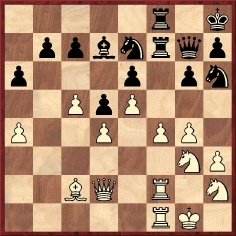
25...Qg8 26 f5 Nhxf5 27 gxf5 exf5 28 Ne2 g5 29 Kh1 h6 30 Nf3 f4 31 Kh2 Rg7 32 Rg2 Bf5 33 Rfg1 c6 34 Nxf4 Bxc2 35 Nh5 Rxf3 36 Nxg7 Bg6 37 Qe2 Qf7 38 e6 Qf4+ 39 Kh1 Rxh3+ 40 Rh2 Be4+ 41 Rg2 Qxh2 mate.
From the entry on Löwenthal on page 122 of the Dictionary of Modern Chess by Byrne J. Horton (New York, 1959):
‘One of Löwenthal’s famous quotations is: “The judicious violation of general principles marks the master-mind”.’
What is the exact source of this observation?
David Picken (Greasby, England) quotes the following from pages 47-48 of World Chess Championship 1954 by Harry Golombek (London, 1954):
‘Watching them today I was struck by the contrast between the players in their actual physical moving of the pieces. Smyslov invariably makes each move with a little flourish and a motion, as though he were screwing in each piece on the board. Botvinnik is strictly utilitarian in his methods. He shuffles the pieces into position almost negligently, as though he knows they will drop into the right place given the slightest encouragement – and so, it must be admitted, they usually do.’
Since recent C.N. items have mentioned Lord Dunsany we reproduce below the inscriptions in one of our copies of Golombek’s book:
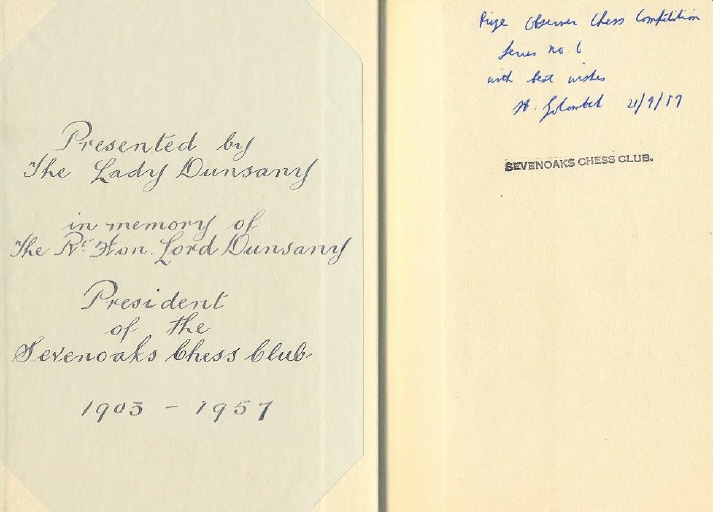
From page 50 of the April 1874 City of London Chess Magazine:
‘We are pleased to hear that a chess match by correspondence is going on between the Felsted and Norwich schools. As far as we are aware this is the first inter-school match that has yet taken place.’
Under the title ‘Chess aids medical science’ the following brief item appeared on page 371 of CHESS, 18 June 1955:
‘Dr P. Gabarro, a prominent Barcelona surgeon is a keen chessplayer. Perhaps that is why the idea struck him that skin grafted on to extensive injured areas might knit better if applied in a chessboard pattern. Anyway, he tried out his “hunch”, and the result, illustrated by grisly but impressive photographs in a recent article by him in the British Medical Journal, has been a great success. “Chessboard grafts” may soon be accepted medical practice.’
This ‘curious problem, composed some years ago’ by J.N.B. was published on page 95 of the 14 August 1909 issue of the Chess Weekly:

‘White can checkmate, self-mate, stalemate, or self-stalemate in two moves.’
Other/better specimens of such multiple problems will be welcomed.
Pages 17-19 of The Best by Peter Passell and Leonard Ross (New York, 1974) have a section entitled ‘The best chessplayer other than Bobby Fischer’ which reviews the various candidates. ‘None of the other Americans, with the possible exception of Sammy Reshevsky and Robert Byrne, plays world championship chess. Reshevsky was eight times the national champion and owned US chess until Fischer came along.’ Karpov ‘belongs to the school of the former world champion Petrosian. Unlike Petrosian, he makes mistakes. That leaves Boris Spassky. ... That Spassky is not as good as Fischer doesn’t mean that he isn’t better than everyone else.’
Everything thus clarified, the alphabetically-organized book moves on to a recipe for ‘The best chocolate mousse’.
Below are two photographs from the 1987 film Capablanca starring César Evora in the title role, from page 10 of the Cuban magazine Bohemia, 26 February 1988:
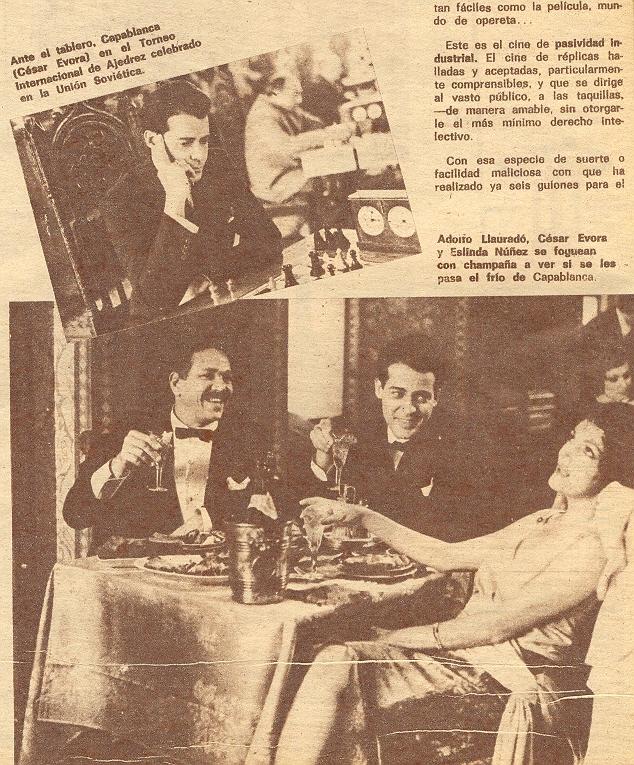
From Martin Weissenberg (Savyon, Israel):
‘In an article on Alekhine at the Chess Café Hans Kmoch recalled:
“... Alekhine used to get angry if his name was pronounced Al-YOH-khin, the way Russians sometimes pronounced it. The correct Russian pronunciation, he said, was Al-YEH-khin, explaining that the name was derived from that of a tree (‘alyesha’) that grew abundantly near one of his family’s estates. ‘Al-YOH-khin’, he claimed, was a Yiddish distortion of his name, like Trotsky for Troitsky or Feigl for the German Vogel. But strangely, no-one whom I ever heard pronounce the name Al-YOH-khin was Jewish.”
Kmoch mentioned that his article was an English version of a paper entitled “Alekhine and his Luck” which had appeared in the Deutsche Schachzeitung, but no publication date was provided.’
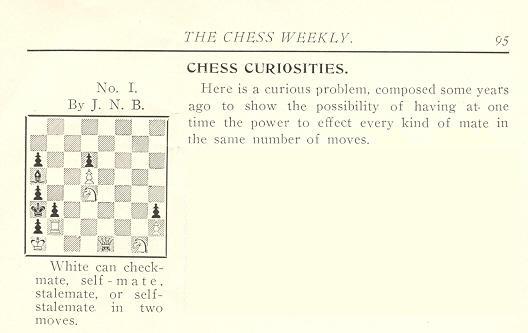
Michael McDowell (Westcliff-on-sea, England) writes:
‘Given that the problem has a short solution in the “stalemate in two” part (1 Qxa5 is immediate stalemate) and no solution in the “self-stalemate in two” part (as there is no way of neutralizing the knight at g1) I imagine that the knight at g1 should be black, not white. If that change is made, the stalemate in two is 1 Qxa5 N any 2 NxN, and the self-stalemate in two is 1 Nc2+ bxc2 2 Qc3+ Bxc3. However, there are then two mates in two: 1 Rxb3+ axb3 2 Qxa5 (presumably the intention) and 1 Qxa5 N any 2 Rxb3. At least the self-mate part 1 Rxa2+ bxa2 2 Qc3+ Bxc3 is sound. The black pawn at a2 is superfluous.’
C.N. 2375 (see page 347 of A Chess Omnibus) reported that when annotating his game against Endzelins in the Munich, 1936 Olympiad (which opened 1 d4 Nf6 2 Bg5) Octavio Trompowsky wrote of the bishop move: ‘My variation, which I have been playing for more than 15 years.’ Source: Deutsche Schachblätter, 15 October 1936, page 368.
We asked if readers could send in corroborative game-scores. That has yet to happen, but Christian Sánchez (Rosario, Argentina) now writes:
‘According to page 181 of El Ajedrez Argentino, June 1947, Octavio Trompowsky gave some games with his opening in his book Partidas de Xadrez.’
Michael Negele (Wuppertal, Germany) has sent us a photograph taken by him of the Nimzowitsch-Enevoldsen ‘double grave’ in Copenhagen:
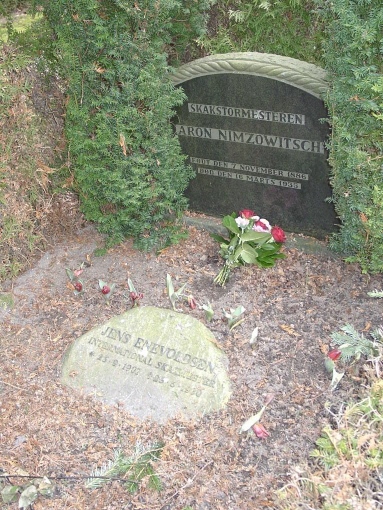
Our correspondent has also provided a photograph of the building in Copenhagen where Nimzowitsch lived (Øster Farimagsgade 11, second floor):

C.N. 2883 (see pages 154-160 of Chess Facts and Fables) related from CHESS, 1949-50 a virulent but informative political argument between, principally, Luděk Pachman and Fedor Bohatirchuk. Now Michael Negele remarks that pages 156-157 of CHESS, April 1980 carried an article by Jurij Semenko entitled ‘Reconciliation After Thirty Years’. It included an English translation of a letter written (in German) by Pachman to Bohatirchuk on 26 January 1979, and some extracts are given below:
‘... when I was barely 17 I was first arrested by the Gestapo and interrogated for several weeks about “incitement to anti-German demonstrations”. You can surely imagine that this was not pleasant. This experience “radicalized” me so that by the spring of 1943 I became active in the underground as a Marxist and a Communist.’
‘My convictions underwent a change soon after our debate. In 1952 (following the major political trials in Czechoslovakia) I resigned from all political offices and decided to devote myself exclusively to chess. Obviously, this was only a half-way, timid decision, since up until 21 August 1968 I still believed that socialism might nevertheless change some day. That 21 August was for me a real “moment of truth”.’
‘... the 16 months of interrogation and torture to which I was subjected. From this imprisonment I was released half-dead, and though three centimetres shorter due to serious injury to my spinal chord, healed in spirit. Immediately after release from prison I returned to the Church and somewhat later (in an interview for Associated Press) publicly explained my reasons for my total break with Marxism. This led to my second imprisonment, where I was sentenced to two years in jail and, soon, to expatriation.’
‘Not long ago, the organ of the Communist Party of Czechoslovakia Rudé Právo in its editorial accused me even of murder, claiming that I allegedly “staged, organized and prepared” the self-immolation of Jan Palach. In fact I never knew Jan Palach.’
‘What more can I say about our polemic of the past? He who does nothing and who does not fight for his convictions makes no mistakes. I have confessed my mistakes a hundred times. Also I have since spoken publicly and written differently about the Vlasov army than in the past, having learned its true history from Solzhenitsyn.
However, while reminiscing about those days I find some consolation in the knowledge that I conducted debates of this type only with people who lived in safety and have not harmed a single person who lived under our system. Precisely because of this I am now meeting in exile people of whom I must ask forgiveness for my past remarks. This I would also like to do in our case.
When in your reply to my article in CHESS you made me an offer to come to Canada, where you would help me, I used to consider it a mockery. Only later it became clear to me that your invitation was a serious and sincere expression of your noble character and your true love for a fellow human.’
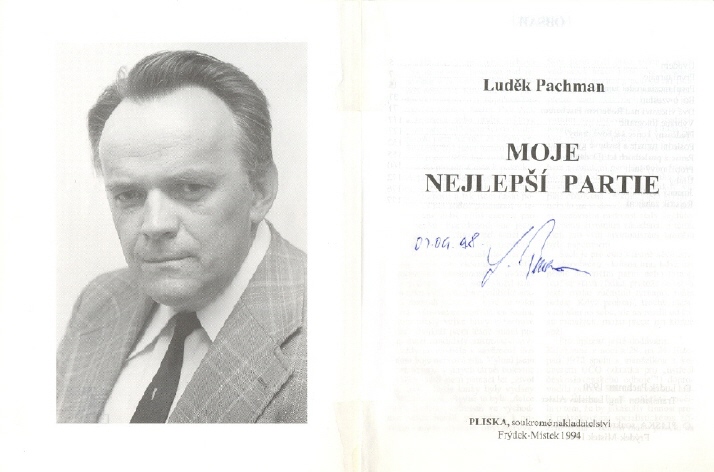
Photographs of Bohatirchuk in chess literature are rare. A poor-quality one appeared on page 103 of VII vsesoyuznyy shakhmatnyy turnir (Leningrad and Moscow, 1933), and Mr Negele has supplied the following shot, from page 3 of issue 20 of 64, 1927:

C.N. 2857 (see page 228 of Chess Facts and Fables) quoted the following from page 25 of G. Koltanowski’s 1968 book TV Chess:
‘In 1933 Salo Flohr played a match with Henry Grob, only Swiss pro. Salo, the former Czechoslovakian chess marvel, won the match five to one. [The result was, in fact, +4 –1 =1.] In the game he lost, the following position occurred:
Black to move played 1…Qb5 and White resigned.
In 1953, 20 years later, Salo Flohr returned to Switzerland, now a full-fledged Russian and as a second to one of the Soviet players competing in the Candidates Tournament in Zurich.
On meeting Grob, Salo did not say “How are you?” Oh, no! The first words he uttered were, “You know, the game I lost to you 20 years ago was a win for me!” Grob was flabbergasted. He couldn’t even remember the position! It seems that a few years after that particular game, giving an exhibition somewhere in Russia, Flohr encountered a schoolboy, who asked him why he had resigned his game against Grob. “Why”, said Flohr, “because I was lost.” “Did you consider after 1…Qb5 2 Kh1?” was the quiet answer. Flohr has been smarting since!’
We indicated in C.N. 2857 that, in reality, the possibility of Kh1 had been pointed out by almost all magazines which published the game in 1933.
Koltanowski’s sweepings are, as usual, of unidentified provenance, but a recent browse through Test your chess by Gerald Abrahams (London, 1975) has presented us with an additional complication. Position 3 was as follows:
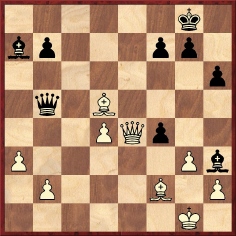
‘In this position, White, to move, resigned. Was that a mistake?’
The following is the solution later in the book (which had no page numbers):
‘This position constitutes the close of a game played by no less than Salo Flohr (White) against the Swiss player Grob in the 1930s.
It looks as if Kh1 for White saves the game; and Flohr, under time-pressure, may have missed this. If 1 Kh1 Qf1+ 2 Bg1.
Perhaps an opponent can be trusted to find what Russian analysts pointed out a few years later, but which is not terribly hard to see: 2...Bxd4!
In answer to this, 3 Qe8+ Kh7 4 Be4+ f5 comes to nothing. Also the sacrifice 3 Bxf7+ can be easily worked out as not leading to a perpetual check.
Acceptance of Black’s sacrifice by 3 Qxd4 is answered by 3...f3, which threatens mate. There follows: 4 Bxf7+ Kxf7 5 Qd5+ Kg6! 6 Qe4+ Bf5 wins.
It therefore appears that White’s position was a lost one, given good play, not easy to analyse, by the opponent ...
Years later, when the justification of his resignation was brought to his notice, Flohr commented: “You thought about it for six years, but I resigned then and there.”’
Whether this alleged dialogue is any more credible than Koltanowski’s script is unclear, but at least Koltanowski’s book had the correct position, whereas Abrahams put a black, not white, pawn on f4 and gave a different queen’s-side pawn configuration.
He was not the first to do so. The conclusion to the game was discussed on pages 99-100 of Der letzte Fehler by Klaus Trautmann (Schwieberdingen, 1999). He related that in 1965 Giorgio Porreca gave the position in L’Italia Scacchistica with a black pawn at f4 (and the incorrect queen’s-side pawns), and that the matter was picked up by Horst Ewald in the 3/1966 issue of Schach. Porreca stated that his source had been a Russian brochure by Boris Wainstein, and much of the discussion involved establishing the correct game-score, a matter not in dispute today. We should, though, like to know when the position first appeared in print as in the second diagram above.
It was the opening game in the Flohr v Grob match, played in Arosa, Switzerland from 26 February to 3 March 1933 (Schweizerische Schachzeitung, March 1933, page 37). Some later books misdated the game 1932, examples being page 275 of The Joys of Chess by F. Reinfeld (New York, 1961) and page 79 of Blunders and Brilliancies by I. Mullen and M. Moss (Oxford, 1990).
In the early 1920s, chess magazines reported that Alekhine had adopted that spelling of his surname. See, for example, page 207 of the May 1922 BCM and page 5 of the January 1923 American Chess Bulletin. However, matters were not clear-cut, and ‘Alekhin’ appeared on the cover and title page of his first Best Games collection, published in 1927:
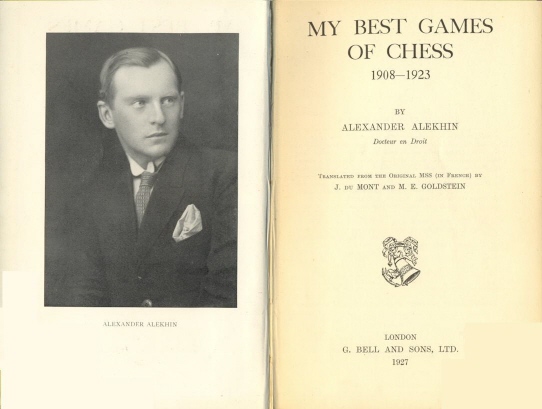
When, in his late teens, he had begun receiving international attention, the chess press spelled his surname various ways. For example:
So when was ‘Alekhine’ first seen? Such a question naturally cannot be answered precisely, but that spelling pre-dates all the above quotes. See, for instance, page 289 of the 9 August 1908 issue of Deutsches Wochenschach and page 258 of the August 1908 Deutsche Schachzeitung. It was also used on page 152 of The Year-Book of Chess, 1909 by E.A. Michell (London, 1909).
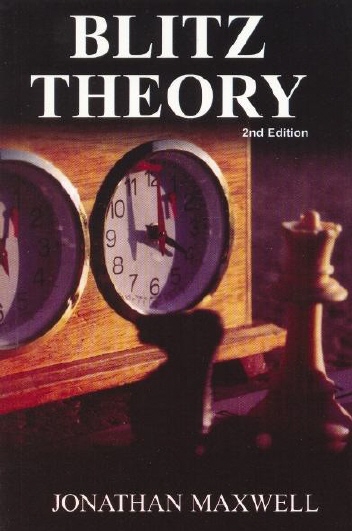
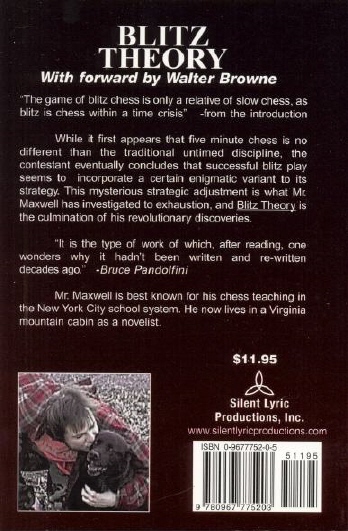
If the only problem with Blitz Theory by Jonathan Maxwell (Flint Hill, 2005) were the typos and shoddy language (enough to have even a Cardoza author looking over his shoulder), the book would not be mentioned here, just as most Cardoza tomes have been passed over in mute dismay. Since, however, the back-cover blurb of Mr Maxwell’s book bills it as ‘the culmination of his revolutionary discoveries’, readers may welcome an inkling of what he has revolutionarily discovered. We therefore pick two examples, the first being on pages 92-93:
‘... when [a piece] is placed with too much inaccuracy, the veteran player is greatly distracted at this “smudge” on the board. By purposely creating such smudges, we can favorably distract our opponent into serious blunders. Let’s look at an example ...
The move Nf5 creates a standard discovered attack on the queen, and will be seen in a typical situation. By placing the knight not directly in the center of the square, but a good ways past the edge of the square, there is a fine chance that the opponent’s flow of concentration will be jostled, and his view of the position will now be skewed in the direction of the “sloppy knight”. Now that he is distracted to the wrong side of the board, there is every likelihood he will miss the attack on his queen, and leave it vulnerable to the naughty bishop.’
On page 96 the revolutionary discoverer offers further counsel which is absent from Chess Fundamentals:
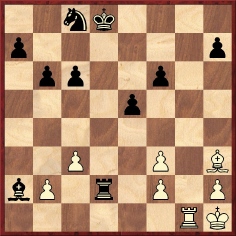
‘When we have an obvious check with a rook or queen, we don’t play the check, but instead say “check” while merely cutting the king by placing the piece on the line adjacent to the check. In the above diagram, our opponent will expect the move to be the Rg8 check. Instead, we say “check” while playing the wily Rg7 blitz tactic! Now there is every chance that upon seeing the typical rook thrust he will move out of the anticipated check, and walk right in to our true check. We can then claim his illegal move as our victory.
This is a perfectly legal tactic. While the unfortunate mark may complain about the validity of the swindle, the fact is that there is no such thing as a “false check call”. Vocal declarations of check have no relevance in blitz or slow chess. Only the board speaks of the king’s danger.’
The back cover sports an appreciative word from Bruce Pandolfini, and the opus has a foreword (‘forward’ three times in Mr Maxwell’s spelling) by Walter Browne. While dissociating himself from ‘the “pseudo check” technique’, Browne writes, ‘Otherwise I endorse this uniquely insightful book with open arms!’
An eminent figure with an enthusiasm for chess was Sinclair
Lewis, who, in 1930, became the first American to win the Nobel
Prize in Literature. Over-the-board encounters with his one-time
secretary, the writer and artist Barnaby Conrad, were related in
Conrad’s memoir Fun While it Lasted (New York, 1969). From
pages 283-285: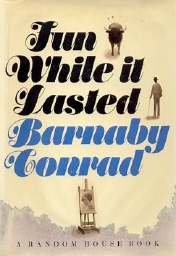
‘That night I played chess with Mr Lewis before dinner. I had studied chess for only a few weeks and had little talent for the game, but I managed to maneuver his king into a bad position fairly soon. I left to go to the bathroom, and when I returned I could swear the pieces had been moved to my disadvantage. But I didn’t say anything and I managed to win anyway. He seemed upset.
“Luck”, he snarled, “sheer luck!”
Then I remembered Marcella’s admonition: “You mustn’t win at chess – not too often, anyway. It’s the most important thing in his day.
He was a trifle sullen at dinner ... He had barely eaten half his dessert when he said, “Now my friend, we’ll see how much beginner’s luck was involved in that first game!”
... He sat down at the chess table and rubbed his hands with anticipation. He immediately set out to lure me into a Fool’s Mate – to beat me in a minimum of moves. Though it was one of the first maneuvers my instructor had showed me how to avoid, I let myself fall into the trap.
“Ah hah!”, he exulted. “That will show you!”
He was delighted and ate three chocolates in celebration. In a euphoric mood he bid me goodnight.’
Below is an inscription by Conrad in our copy of his book:

C.N. 3599 commented, ‘Reinfeld quoted his remark on page 293 of The Treasury of Chess Lore (New York, 1951), but we do not know when he first came up with it’. That remains the case, but page 32 of the March 2006 CHESS points out that it was also attributed to Reinfeld when quoted under the chapter heading on page 7 of an earlier work, Winning Chess (co-authored with Irving Chernev). That book was first published in 1948 (not 1949 as stated by CHESS), and the quest continues for any previous appearance of the phrase in Reinfeld’s output.

The above comes from page 108 of Reinfeld’s 1941 book Keres’ Best Games of Chess 1931-1940. Its significance is that the first part of the note to White’s 25th move is quoted in the Oxford English Dictionary as the earliest known occurrence of the word Zwischenzug in an English-language text.
Readers’ help in looking for older instances will be appreciated.
Our feature article on Zugzwang commented: ‘... the term Zugzwang was not commonly found in English-language chess literature prior to the publication of My System’ [in 1929]. That still reflects our reading, but we now note a remark by Emanuel Lasker on page 19 of Lasker’s Manual of Chess (New York, 1927): ‘The constraint to move is usually called by a German word, “Zugzwang”, that has become international in its usage.’
The earliest sighting of Zugzwang in an English-language chess source remains page 166 of the February 1905 issue of Lasker’s Chess Magazine. See page 198 of A Chess Omnibus.
The earliest citation for Sitzfleisch in the Oxford English Dictionary is dated 1932 (The Lovely Lady by D.H. Lawrence), but Joost van Winsen (Silvolde, the Netherlands) quotes the following from page 121 of The Principles of Chess in Theory and Practice by James Mason (London, 1894):
‘A player has been known to refuse to proceed, on the ground that if he did so mate would happen to him forthwith. Another declared that as he could not afford to lose the game, it was incumbent upon him to “sit out” his opponent on that particular occasion. These are extreme cases, no doubt, but that they were possible and actual is unquestionable. In short, Sitzfleisch was the ultima ratio, and often prevailed.’
We happen to be able to quote an even earlier occurrence of the word, on page 113 of the December 1881 Chess Monthly:
‘It is Sitzfleisch that decides a game.’
Below for reference is the full pseudonymous letter from ‘Philidor Jones’:
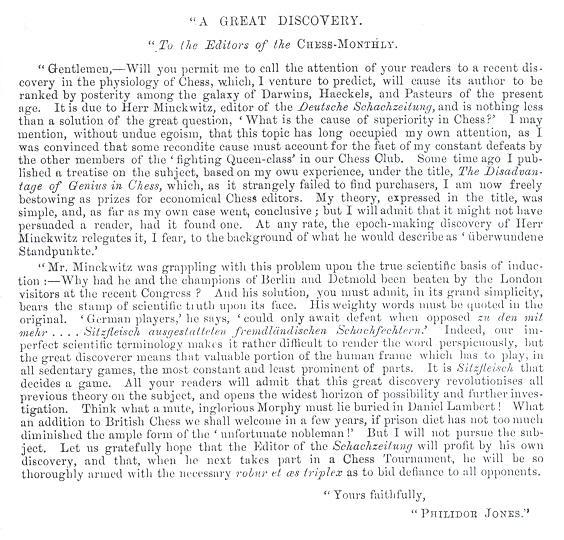
C.N. 2916 raised the subject of unusually ornate diagrams and mentioned a nineteenth-century edition of Philidor’s Análisis del juego de ajedrez:
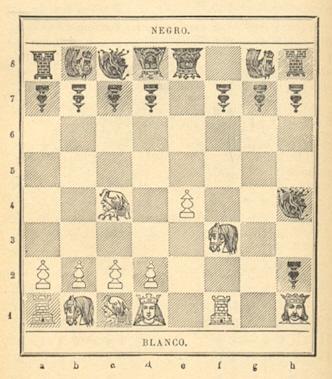
We welcome not only similar specimens but also sightings of the unsightly, i.e. anything worse than the following, from page 87 of Schachkuriosa by Helmut Swoboda (Zurich, 1965):

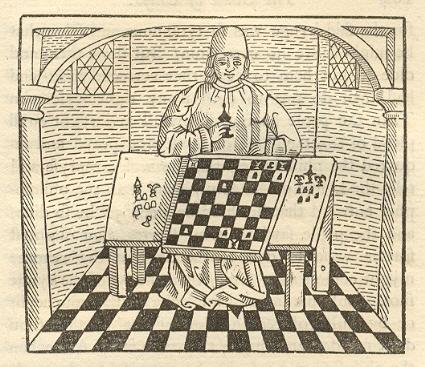
The Chief Editor of the Oxford English Dictionary, John Simpson (Oxford, England), writes:
‘It is very interesting to note the early citations for chess terms and “chessy words” which have been given in Chess Notes, and any further discoveries from you or your readers will be much appreciated.’
We are now launching a special feature article, Earliest Occurrences of Chess Terms, the intention being to build up a comprehensive listing of citations from English-language publications. A note at the end of the article explains how readers can assist. As ever, correspondents are requested to provide their full postal address, but some may prefer, in this instance, not to be named publicly if making off-the-cuff suggestions for earliest occurrences. Indeed, for this feature we shall welcome such spontaneous proposals; after all, a start has to be made somewhere in tracking the first appearance of, for instance, ‘blitz chess’.
The listing is intentionally making a modest start, and we ask all readers kindly to consider contributing proposals, references, improvements and corrections.
Per Skjoldager (Fredericia, Denmark) recently acquired a postcard signed by a number of masters at Portorož, 1958. The signatures of Cardoso, Fischer, Gligorić, Kostić, Larsen and Pachman are recognizable, but what about the others?
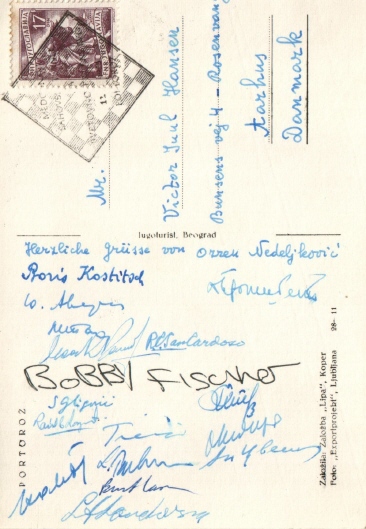
From Michael McDowell (Westcliff-on-sea, England):
‘The multiple problem by J.N.B. (i.e. Babson) was published, with a black knight on g1, on page 292 of Brentano’s Chess Monthly, October 1881. I cannot find a solution in any later issue of Volume 1. A number of multiple problems were given in that volume (on, for example, pages 349, 442, 447, 450 and 519).
Most modern multiple problems feature different genres and the same stipulation. For instance, the diagram may be a helpmate in two in orthodox chess and Circe chess, Madrasi chess, or other fairy forms. The modern composer tries to incorporate thematic ideas in multiple problems.’
Our correspondent provides the following example, noting that ‘the cyclic shift idea is termed the Lačný theme’:
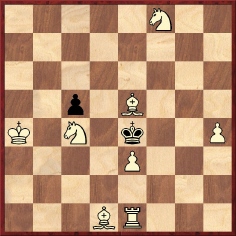
Peter Gvozdják, Second Prize, Pravda –
Tirnavia 1987
a) Mate in two. b) Stalemate in two.
As regards the J.N.B. problem, we note that whereas the 1909 Chess Weekly wrote that it was ‘composed some years ago’, Brentano’s Chess Monthly stated in 1881 that it was ‘composed a long time ago’.
C.N.s 3686 and 4011 reported that Everyman Chess had announced Rudolph Spielmann Master of Invention by Neil McDonald. The book has now been published, and it is good to see that Rudolph has been duly corrected to Rudolf.
Michael Clapham (Ipswich, England) draws attention to a rare monograph on Fischer:
‘Bobby Fischer Against the World’s Champions & Leading Grandmasters by F. David was published in Manila in 1975 by “F. David Printing House”. It is 36 pages long and comprises a short biography and 37 Fischer games (mostly unannotated, but a few have the odd remark). It is in English throughout but is not recorded in Lusis’s 1991 bibliography.’
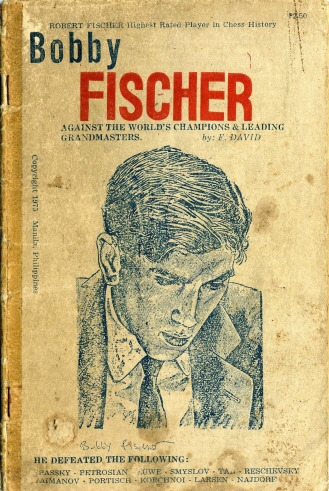
C.N. 3931 gave a victory attributed to General Tom Thumb on page 216 of Brevity and Brilliancy in Chess by Miron J. Hazeltine (New York, 1866). We noted that the heading was ‘A Mate by General Tom Thumb (At least S. Loyd says it was.)’ and that Loyd was named as the General’s victim.
Now Harrie Grondijs (Rijswijk, the Netherlands) mentions that the game appeared on page 132 of The Philadelphia Times Column of G. Reichhelm, 1879-1894, published by Caissa Editions, Yorklyn circa 1984:
‘General Tom Thumb according to the Editor of the News is an excellent chess player for his size. The first game, the only one recorded between the General and the Editor, was as follows: TT (White) – Editor (Black) 1 e4 e5 2 Nf3 Nc6 3 d4 exd4 4 Bc4 Nf6 5 Ng5 d5 6 exd5 Nxd5 7 Nxf7 Kxf7 8 Qf3+ Kg8 and the General announced a mate in three.’
Our correspondent notes that the column is undated, which makes it particularly difficult to identify ‘the Editor of the News’.
Sandro Litigio (Como, Italy) writes:
‘The Italian term for skewer is “infilata”. The entry on pages 278-279 of the Dizionario Enciclopedico degli Scacchi by Adriano Chicco and Giorgio Porreca (Milan, 1971) limited itself to cases where check is given:
“È lo scacco al Re, dietro il quale sulla stessa linea di azione del pezzo che dà scacco, trovasi un altro pezzo avversario ...”
The example presented was a study from Civis Bononiae (1454).’
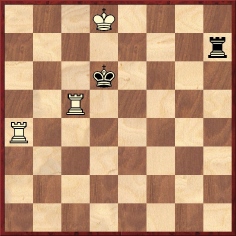
1 Rh5, and if 1...Rxh5 2 Ra6+ Kc5 3 Ra5+ ‘e con lo scacco di infilata il Bianco guadagna la Torre’.
Various C.N. items (see pages 119-120 of Chess Facts and Fables) have discussed ‘wood words’ (involving shifting, pushing, thumping, shuffling and chopping), and here we add the term ‘wood-thumpingitis’, from an article by Bruce Hayden on pages 106-107 of the April 1951 Chess Review which was reprinted, with a few textual changes, on pages 9-15 of his book Cabbage Heads and Chess Kings (London, 1960):
‘In 1947, Harold [Lommer] went into partnership with one Boris Watson, a fellow addict. Boris, a gentle, scholarly man of precise speech, is a tall, majestic figure of 20 stone who suffers from wood-thumpingitis of the right arm – he’s an enthusiastic wood-thumper and likes nothing better than to moor himself solidly against a chess table and play quick skittles. Harold gives Boris the odds of ten stone and a knight ...’
‘Il m’aborde. “Ah, ah, vous voilà, monsieur le philosophe, et que faites-vous ici parmi ce tas de fainéants? Est-ce que vous perdez aussi votre temps à pousser le bois?” C’est ainsi qu’on appelle par mépris jouer aux échecs ou aux dames.’
Our correspondent gives the following English version from page 36 of the 1966 Penguin edition of Rameau’s Nephew, translated by Leonard Tanock:
‘He accosts me ... “Aha, there you are, Mr Philosopher, and what are you doing here among all this lot of idlers? Are you wasting your time, too, pushing the wood about?” (This is a disparaging way of referring to the games of chess and draughts.)’
We add that pages 144-145 of King, Queen and Knight by N. Knight and W. Guy (London, 1975) gave the above passage ‘translated by Professor Raoul Gaudin for the compilers’. Or is it the same passage? No reference to draughts is included, and the text reads, ‘Are you also losing your fame in wood shifting’.
On page 298 of the October 1951 Chess Review Bruce Hayden wrote:
‘My friend and fellow club member, Daniel Costello [sic], is a great enthusiast and even greater wit.’
This was Daniel Castello, who died in 1980 and was mentioned as follows by R.G. Wade on page 527 of the October 1980 BCM:
‘D. Castello will be remembered for his pains-taking proof-reading of many books – Tartakower described him as “The Prince of Proof-Readers”.’
Whether that remark was made by Tartakower in print we cannot say, but certainly Castello’s proofreading was acknowledged in books by Tartakower and by du Mont. Moreover, Tartakower’s A Breviary of Chess (London, 1937) contained English-language versions by Castello of a number of short poems (‘quatrains’) by Jules Lazard. Available on-line at various websites, they are well worth reading, in both French and English.
In part 128 of Bréviaire des échecs (the page number varies from one edition to another) Tartakower introduced a section on Lazard’s verse as follows:
‘De diverses conceptions du jeu des Echecs. Les vers sont extraits du recueil Echéphiles et Echémanes de Jules Lazard.’
The publication details of Echéphiles et Echémanes are being sought, as is further information about Lazard. In the meantime we note that on pages 443-444 of issue 14 of Les Cahiers de l’Echiquier Français (1928) Lazard proposed three words to describe chessplayers:
‘Echéphiles – Amis du noble jeu.
Echémanes – Ceux qui le jouent sans trop le connaître, qui jouent avec les échecs et non aux échecs.
Echéphobes – Les ennemis du jeu.’
The periodical then gave the following poem by Lazard, which includes a reference to woodpushing:
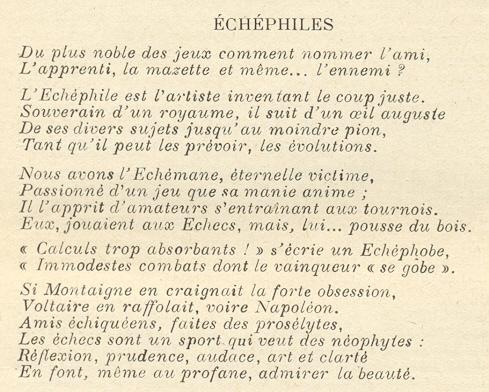
Page 264 of the first edition of Tartakower’s A Breviary of Chess named three politicians ‘amongst public men of our time who are keenly interested in the game’: Bonar Law, Sir John Simon and Leslie Burgin. Burgin is all but forgotten nowadays, and even in the 1930s he was not exactly a high-flying minister in the British Government. J. du Mont dedicated The Basis of Combination in Chess (London, 1938) ‘to my friend Leslie Burgin’.
A number of C.N. items (see pages 330-332 of Chess Facts and Fables) investigated the origins of the well-known saying ‘the threat is stronger than the execution’. Our starting-point was a book which attributed it to Tartakower, but eventually it was traced back, via Nimzowitsch and Mason, to Karl Eisenbach (1836-1894). The source for that was a report by Marco (found by our correspondent Peter Anderberg) on page 111 of the March-April 1908 Wiener Schachzeitung.
All that we can currently add is that in a list of ‘maxims and advice’ on page 229 of A Breviary of Chess Tartakower included ‘A threat is more powerful than its execution’, and attributed it to Tarrasch.
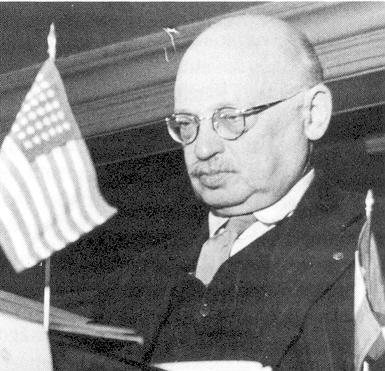
Savielly Tartakower
Concerning the famous ‘Tartakowerism’ about an isolated pawn spreading gloom all over the chess board, readers are invited to use a search-engine for a little test:
a) How many webpages have the quote?
b) How many webpages have it with a source?
Can readers improve on past efforts to find the earliest instances of moves being awarded exclamation and question marks (see page 116 of Chess Explorations)?
In C.N. 622 G.H. Diggle wrote:
‘The first “exclamation mark” I can discover is in Chess Player’s Chronicle Volume 1 page 4 (Staunton v Popert) but it was put in brackets (!) and denoted not a good move but a blunder! Walker’s Chess Studies occasionally does the same thing (see games 889 and 946). The earliest modern use of ! that I can find is in the BCM 1881, page 124 (Thorold v Wayte).’
In C.N. 647 another correspondent, Rob Verhoeven, pointed out that page 6 of Cook’s 1874 book Synopsis of the Chess Openings gave a list of abbreviations which included =, ! and ?, whereas Lange’s Jahrbuch des Westdeutschen Schachbundes 1862 used (!) and (?).
Mention of G.H. Diggle prompts us to give another of his articles, from page 5 of volume one of Chess Characters (Geneva, 1984). Entitled ‘Tartakower saves the day’, it was originally published in the March 1975 Newsflash. As usual, Diggle referred to himself in the third person, as ‘the Badmaster’.
‘Towards the end of the War, the Badmaster (then stationed at an RAOC Depot in London) went along to the Lud-Eagle Chess Club to watch a friendly match between the Club and the “Combined Forces”. Playing top board for the latter was the renowned Tartakower (then known as Lieut. Cartier of the FFF). In those uncertain days picking a “Forces” Team was a precarious operation; sudden unavoidable absence was rife – substitutes had to be roped in at a moment’s notice – and “fools who came to watch remained to play”. Thus the BM found himself in the match, playing White against an opponent about a class and a half stronger than himself. But luckily the time for play was rather short; and at adjudication time the BM was only a pawn down – his remaining pieces, though wretchedly deployed, were still in the shop window. His courteous and easy-going opponent did not immediately proceed to demonstrate a dozen ways of winning, but merely said, “Oh, well, let the bright boys have a look at it” (though there were not so many “boys” brighter than himself present).
When the “bright boys” arrived, they swore to a man that the Badmaster had “had it”. But the result of the match depended on this game, and someone suggested – “Let Cartier have a look at it”. The Great Master, having been fetched, sat down at the board very simply and unaffectedly, and drank in through his spectacles the fruits (and probably the whole deplorable history) of the BM’s afternoon strategy. First he shook his head in silence, but presently (like Dr Johnson) he was perceived to be “rolling himself, as about to speak”, and sentence might well have been instantly pronounced, when the BM was unexpectedly saved by the gong.
The “gong” in question was a blasé voice from the crowd. Just as Cartier was about to speak, the voice pipped him at the post by murmuring in an audible drawl: “BLARK AWBVIOUSLY WINS”. The Great Master paused. Was he merely to nod his head in agreement like a puisne judge, leaving everyone to infer that he, the expert, had only just arrived at a conclusion that had been “awbvious” all the time to the owner of the blasé voice? Instead, he rose to the occasion. “It is difficult”, he began slowly. “It is not quite a clear win for White – I say for WHITE.” (Incredulous sensation among “bright boys”.) “I SAY FOR WHITE”, reiterated the inexorable Cartier, and proceeded to rush through half-a-dozen variations at lightning speed – under his magic touch the white pieces became coordinated in no time, and white passed pawns sprang up like crocuses. Then, before the “bright boys” had got their second wind, the great man looked at his wristwatch, rose from his chair, exclaimed, “Well, perhaps a draw” and departed. Draw duly recorded. The BM staggered back to Barracks in a sort of stupor, vaguely muttering “Thank God for British Justice”.’
We shall be reverting to the signatures on the postcard presented in C.N. 4319, on the basis of contributions received from readers. In the meantime, here is a rather easier specimen to scrutinize, from one of our copies of Winning Chess Traps by Irving Chernev (New York, 1946):

Page 80 of the Dictionnaire des échecs by F. Le Lionnais and E. Maget (Paris, 1967) presented what was described as the most astonishing of all coincidences in the problem field (‘la coïncidence la plus étonnante que l’on ait sans doute enregistrée dans ce domaine’), i.e. a two-mover published in the magazine of the Good Companion Chess Club in 1920 which had been composed ‘simultaneously and independently by five problemists’:

Such a coincidence would seem incredible, and so it is. Michael McDowell (Westcliff-on-sea, England) writes:
‘There were two Test Papers set by Comins Mansfield for the Good Companion Folders in 1919. Each offered five questions, which competitors were to answer by contributing problems meeting the specified conditions. The relevant question was given at the top of page 95 of The Good Companion Two-Mover by George Hume and Alain C. White (A.C.W. Christmas Series 1922):
The setting of 47D is very light, so it is not surprising that five composers should have come up with similar settings. I checked with the librarian of the British Chess Problem Society, John Beasley, and only the Bettmann setting was published in Our Folder for May 1920. The text in The Good Companion Two-Mover is practically identical to that in the Folder. If the Dictionnaire des échecs is suggesting that the five composers submitted identical settings, I think that is incorrect. The settings probably differed only in very slight respects, e.g. one or two pieces starting on different squares, but if any had been identical to Bettmann’s I am sure the composer would have been acknowledged above the diagram. Probably Bettmann’s setting was selected for a diagram because it was considered to have the best key, or the neatest appearance, but it is impossible to tell without seeing the other versions.
As regards the composers’ names as given by the Dictionnaire: W.B. (not B.W.) Rice; Verveen (not van der Ven, who was a different composer). Ua Tane was the pseudonym of James Frank Stimson.’

We are grateful to Charles Milton Ling (Vienna), Hassan Roger Sadeghi (Lausanne, Switzerland) and Dan Scoones (Victoria, BC, Canada) for identifying various signatures, in addition to those mentioned in C.N. 4319 (which were Cardoso, Fischer, Gligorić, Kostić, Larsen and Pachman). The collective result of our three correspondents’ submissions is the following:
Averbakh (below Kostić) and Tal (below Averbakh). To the right of Kostić: Bronstein. Below Gligorić: Sanguineti. Below the word ‘Fischer’: Petrosian.
From Michael Clapham (Ipswich, England):
‘There are plenty of examples of exclamation marks in the BCM of 1881 before page 124. They start on page 23, where there is a note at the bottom of the page stating,“This sign (!) denotes ‘best move’”. The game between Wayte and Schmid on page 24 has exclamation marks for three moves in a row.
Page 253 of the Westminster Papers for 1 April 1874 includes an example of the double exclamation mark in the note to Black’s 33rd move in the game Madan-Keynes.’
An easier question than usual: name any players who, when barely into their teens, had already had two chess books dedicated to them.
From page 39 of volume two of Chess Characters by G.H. Diggle (Geneva, 1987) comes another article by the Badmaster, originally published in the May 1986 issue of Newsflash:
‘One hundred and fifty years ago (on 8 May 1836) there appeared in the old sporting paper Bell’s Life in London what was probably the first review of a new chess publication ever to be written. The reviewer was that racy chess editor George Walker, once described as “the reprobate of a pompous chess era”:
“We have just received the first number of Le Palamède, a new French monthly magazine devoted to chess – editors La Bourdonnais and Méry. The plan of the work is at present better than the execution, but being young there’s time to improve. The style is too stilted – too much of the “roaring boy” and the “I and Jupiter”, but this will rub down. The editors play fast and loose between jest and earnest – they give us an anecdote of Deschapelles playing the Club at Berlin which we hope is not true, otherwise it depicts conduct so stupidly vulgar on the part of the Frenchman that the Prussians ought to have done themselves justice by pumping on him. Dull as we are from our beef and pudding in this tight little island, we will grant that Deschapelles can give us pawn and two when we have seen it done. With all that gent’s talk about advancing chess by de belles parties his exertions in this respect have hitherto been remarkably quiescent. Where is his treatise on chess? Where are his brilliant games, played by himself? Alas, to these queries it seems that only one answer can be given – THERE ARE NONE!”
A still more trenchant review by Walker was published in 1848, when he uncovered, much to his own delight, a mild chess “Watergate” which involved his arch-enemy and rival author, William Lewis. A new chess book appeared purportedly written by “Carl Frederick Vogt”, a mysterious German who had never been heard of before, and translated into English by another literary “newcomer”, Mr U. Ewell. The book discussed extensively the relative merits of various authors on the game from Lucena onwards, and particular praise was awarded to William Lewis. But alas, it turned out not only that Herr Vogt was a “Herr” in nubibus but that Mr Ewell had achieved a transformation of identity which Dr Jekyll would have envied:
“U. Ewell – You You Ell – Double You Ell – W.L. – W. Lewis!”
Walker recommended the book as follows:
“Under the title Letters on Chess conveying pleasing promise of matter at least original we have been duped into buying a four-shilling volume, or rather pamphlet, of 134 widely printed pages, purporting to be translated by one Mr Ewell, from the German of one Mr Vogt, and to treat of the merits of authors on the game. The writer might have been Shem in the Ark addressing Japhet, considering that he knows nothing of any writer on chess since 1828, save Lewis. From this and various other indications it is more than probable that the book is the production of Mr Lewis himself, particularly as his great name is emblazoned gloriously in the Lewis style on every page, and it has long been notorious that Mr Lewis is unhappily ignorant of the existence of any author since his own epoch – the year One. Four shillings is the price of this ponderous and solemn trash – at four penn’orth of bad coppers the stuff would have been equally ‘a sell’.”
Lewis never acknowledged the work was his, though it was produced by his own publishers. But setting aside the “Lewis laudation”, it was by no means such “trash” as Walker made out. John Keeble once showed the BM a letter he had received from H.J.R. Murray, who wrote: “The review does not increase one’s opinion of Walker, and is equal to Staunton at his worst”.’
For readers less familiar with G.H. Diggle than they would wish we reproduce below our tribute to him on page 46 of CHESS, June 1993:
‘Geoffrey Harber Diggle (born in Moulton, Lincolnshire on 6 December 1902) died in Brighton on 13 February 1993. Affectionately christened the Badmaster by C.H.O’D. Alexander (who also described him as “one of the best writers on chess that I know”), G.H.D. contributed many fine articles to the BCM (1933-1981) and the BCF’s Newsflash and Chess Moves (1974-1992).
Specializing in nineteenth-century chess history (particularly the Staunton period), he brought the old masters to life with rare wit and shrewdness. These qualities also permeated his accounts of the idiosyncratic doings and sayings of club “characters”, such as the elderly player “who fumbled his way to perdition at reasonable speed until he was a queen and two minor pieces to the bad, after which he discovered that ‘every move demanded the nicest calculation’”, or “the Lincoln bottom board of 1922, who complained that he had ‘lost his queen about the third move and couldn’t seem to get going after that’.”
A former county champion, G.H.D. was charmingly self-deprecatory in his reminiscences, as when he had a game adjudicated by Tartakower: “The Great Master, having been fetched, sat down at the board very simply and unaffectedly, and drank in through his spectacles the fruits (and probably the whole deplorable history) of the Badmaster’s afternoon strategy.”
Little escaped G.H.D.’s eye, even towards the end. Modestly adapting Oscar Wilde, he claimed to have “nothing to declare but his longevity”, simply adding that he had “mingled from time to time with three generations of eminent players ranging from Isidor Gunsberg to Nigel Short, and rambled extensively round the highways and byways of provincial chess”. He was one of the game’s most stylish chroniclers.’
Chess Notes Archives:
| First column | << previous | Archives [21] | next >> | Current column |
Copyright 2006 Edward Winter. All rights reserved.